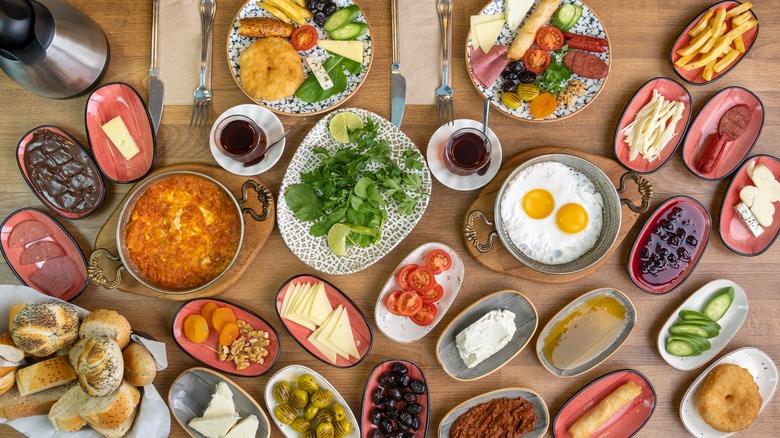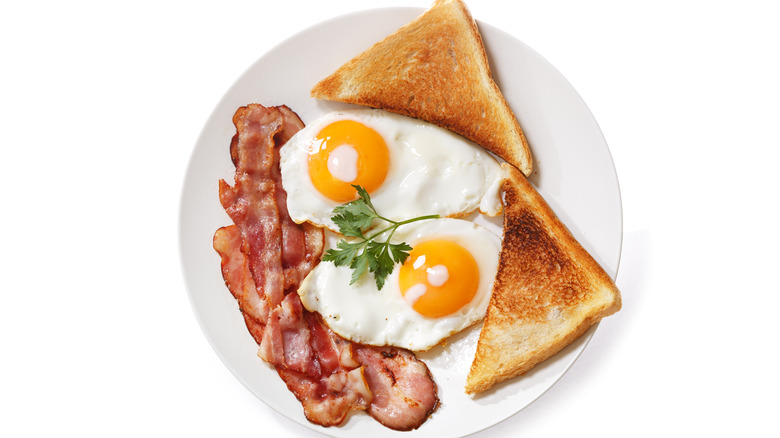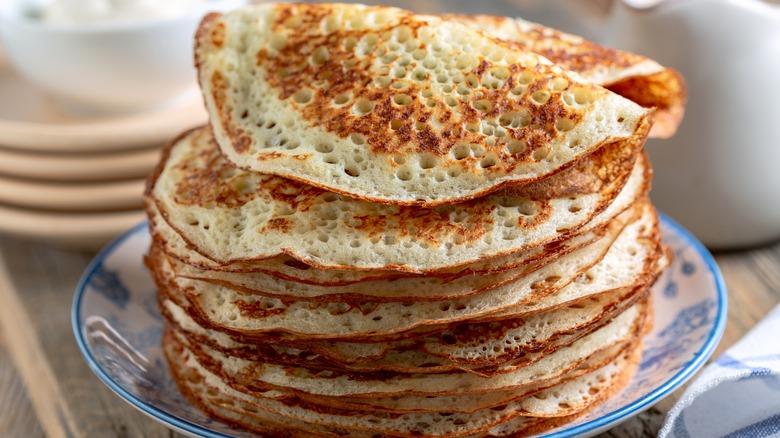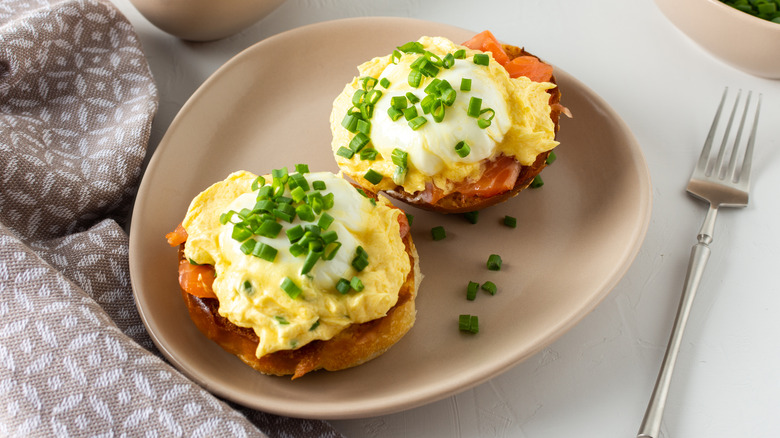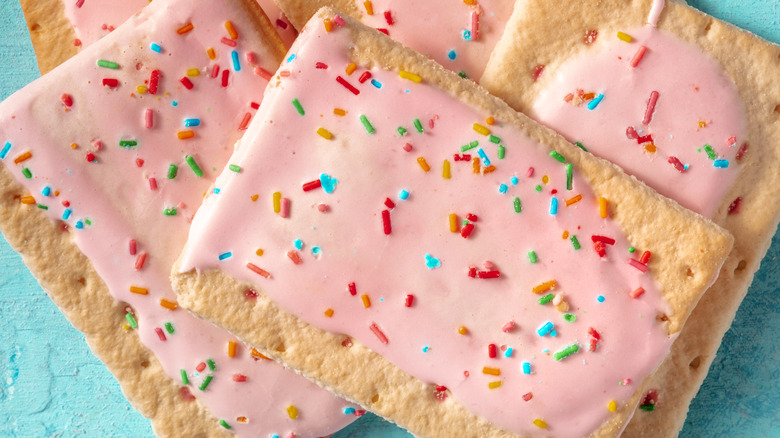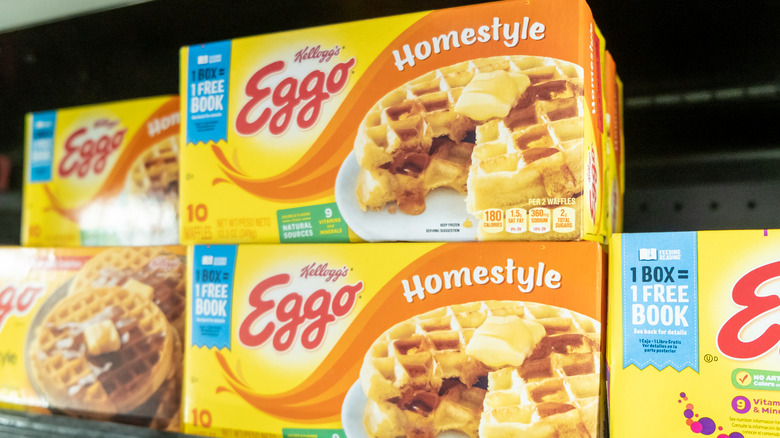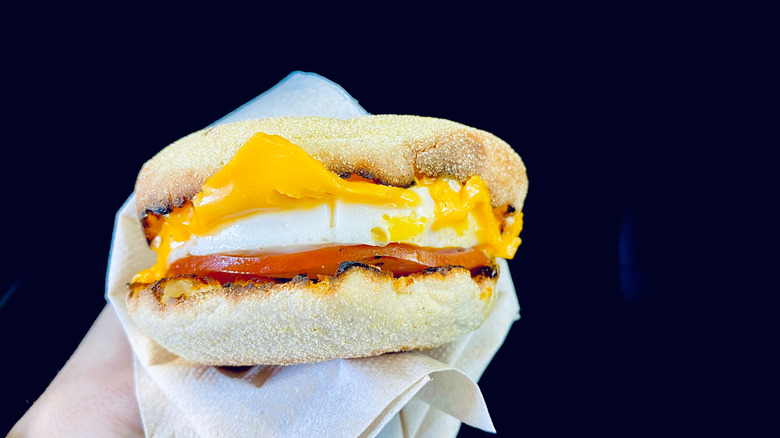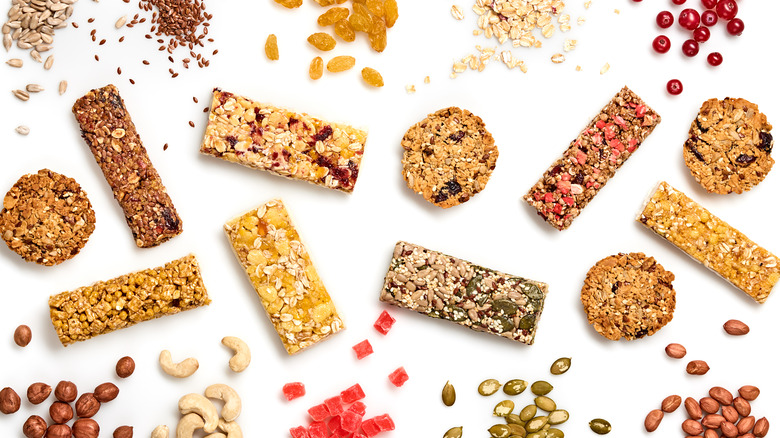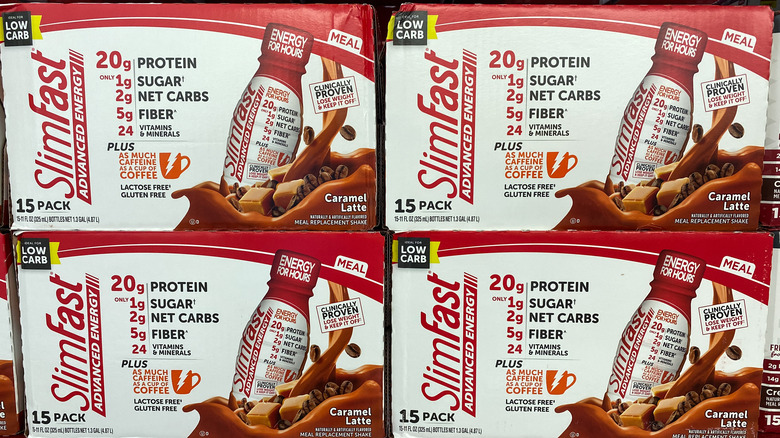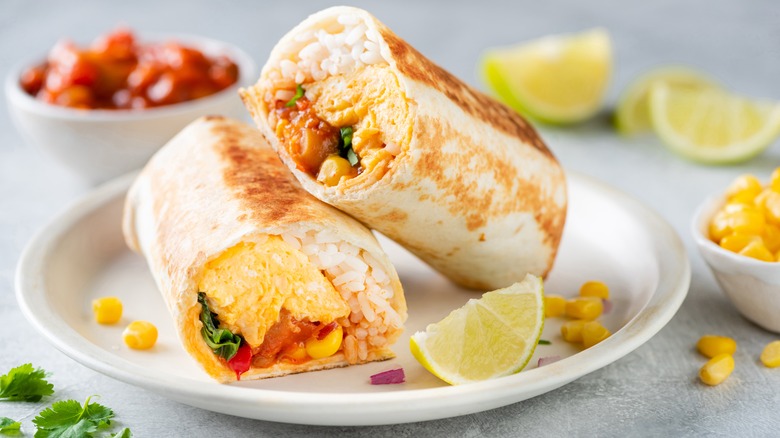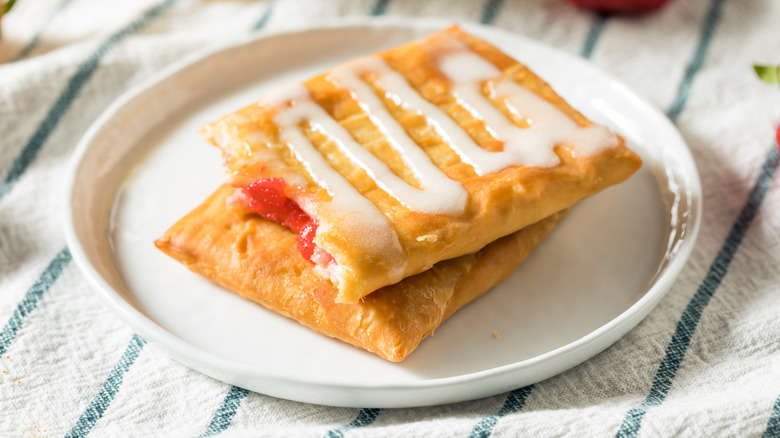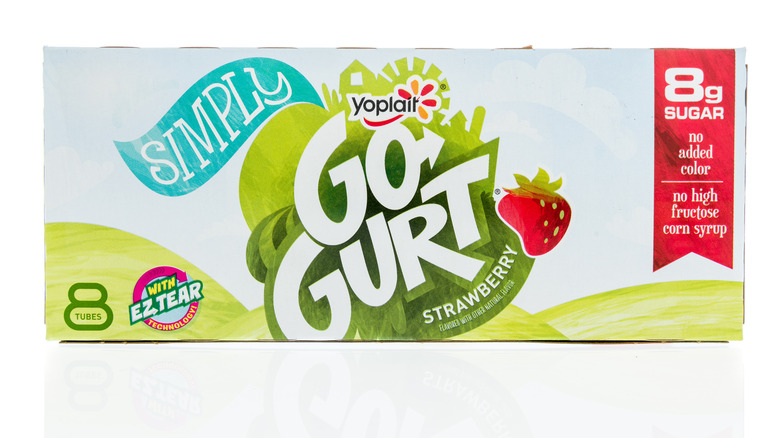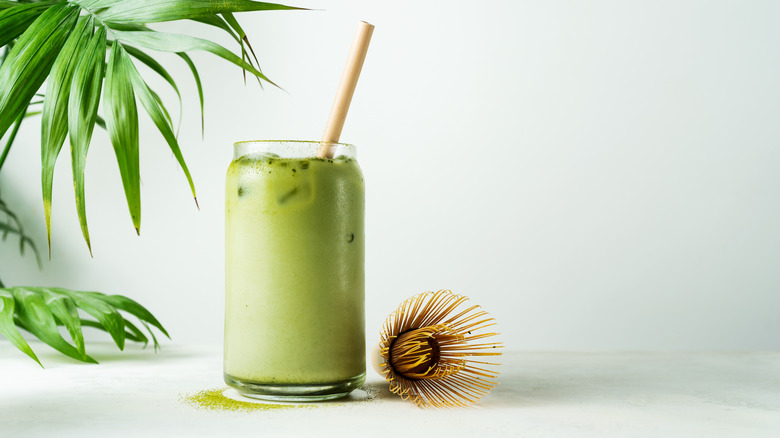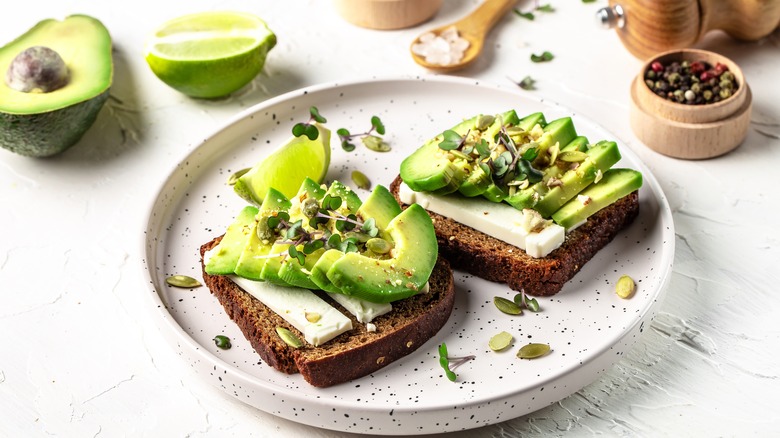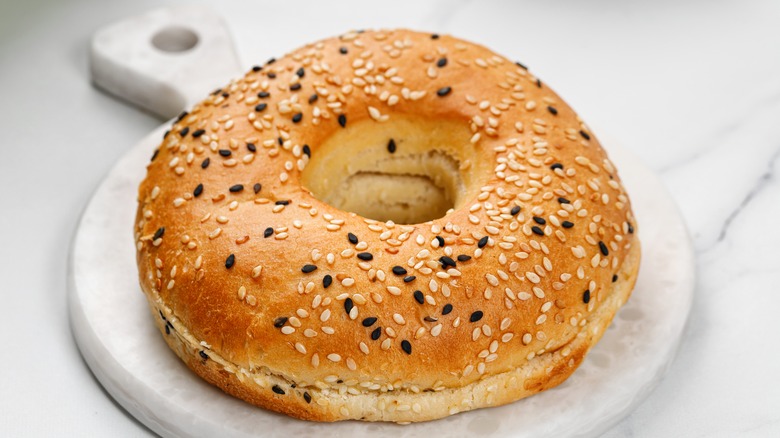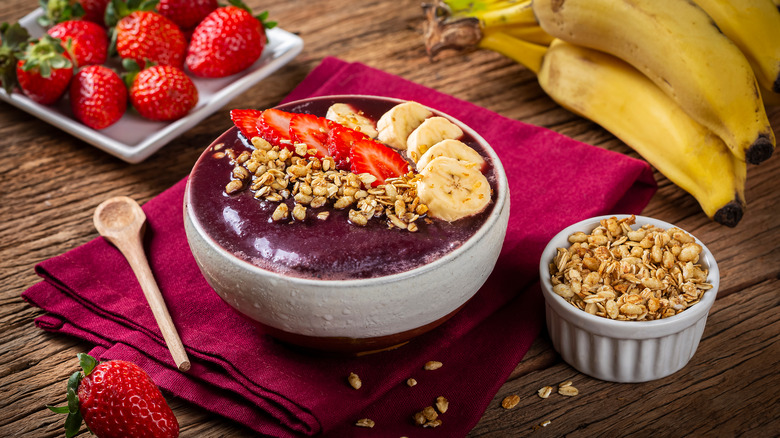The Most Popular Breakfast Food The Year You Were Born
Breakfast: It's the most important meal of the day, or so it's said. Some claim it's essential to your overall health (via Better Health Channel). Others forgo the meal and wait until mid-morning or lunch to break their fast. No matter where you land on the spectrum, you've certainly eaten breakfast at some point in your life, and you likely have a favorite item.
Collectively, Americans have had favorite items, too. Humans like to do what other humans are doing, and that includes eating certain breakfast foods. Though we're not certain why some foods are designated for the morning and others aren't, we all have particular foods associated with breakfast, and those associations have changed over time.
Whether it's from shifts in culture or a new product being released, Americans have changed their favorite breakfast items rapidly over the last century, and you're probably curious what's led to those changes. Read on to discover the most popular breakfast food from the year you were born, and just why it was so popular.
Bacon and eggs: 1950 - 1957
Bacon and eggs have been popular forever, it seems — obviously neither of these foods were invented in the 1950s. In fact, bacon goes back as far as 1500 BC. As far as eggs go — they've have been around since, well, the beginning of chickens.
Nevertheless, bacon and eggs were super popular in the 1950s. The 1950s were a time of very different societal norms than those of today, particularly the dynamics at home. There was, in most households, a husband who went to work to bring home the (dare we say) bacon, and a wife at home to cook it. Wives were expected to provide a family with full-fledged meals each day, and that included bacon and eggs.
Looking at the dish from that standpoint, it's understandable why it was so popular. Bacon and eggs are simple and quick to make. While bacon is a little pricey (at least comparing prices to the 1950s), eggs are an economical food — and both are great sources of protein that provide energy.
Pancakes: 1957 - 1960
Another food to have maintained its historical popularity is pancakes. Pancakes have been around for centuries. According to Betty Crocker, the first record we have of the fluffy breakfast food comes from 600 BC in ancient Greece. A poet wrote about pancakes, though to our knowledge he did not give a recipe.
However, in 1957, pancakes experienced a surge in popularity thanks to Quaker. The food brand that has been providing consumers with easy-to-make foods and mixes for decades introduced a product that changed breakfast for the foreseeable future, and that was Aunt Jemima's Buttermilk Pancake and Waffle Mix.
We can only assume it was a welcome respite for all the housewives 1950s who were still subject to cooking their families bacon and eggs for breakfast on a daily basis.
Eggs Benedict: 1960 - 1964
If fancy brunch comes to mind when hearing eggs Benedict, you are not alone. The lovely concoction of a poached egg, Canadian bacon, and hollandaise sauce atop an English muffin was uber popular in the early '60s. And unlike many of the foods that gained popularity because they were created in that decade, eggs Benedict has been around since the 1890s — though its origin is widely disputed.
What we do know is that eggs Benedict was added to menus sometime in the 1940s — after World War II, the breakfast dish became even more popular as more people were able to afford what had previously been seen as elitist, like eating at restaurants.
But eggs Benedict took a little while to find its place. It was seen on both breakfast and lunch menus for a time, but in the 1960s it was cemented as a classic brunch item which accounted for its popularity of the era.
Pop-Tarts: 1964 - 1971
To anyone under the age of 40, it may be surprising to learn that Pop-Tarts have existed since the 1960s. If you're a millennial, you likely view the toaster treat as a staple childhood breakfast item, but as it turns out, an entire generation before you was fortunate to have a Pop-Tart in the morning, too.
Pop-Tarts first hit shelves in 1964, but they looked a little bit different. Yes, they had their signature rectangular shape, but they were missing that deliciously-hard frosting on top. They looked more like unfrosted Toaster Strudels than the Pop-Tarts of today, and they only came in four flavors — Strawberry, Apple Currant Jelly, Blueberry, and Brown-Sugar Cinnamon — most of which are still available today.
Despite lacking frosting, the breakfast treats, named for Andy Warhol's pop art influence, completely sold out in the United States after their first shipment. Within two weeks, Pop-Tarts were unable to be purchased; everybody just had to wait for more to come. How's that for popularity?
Eggo Waffles: 1971 - 1975
Toasters were having a moment in the 1960s and 1970s. And in 1970, Kellogg's capitalized on the love for the household appliance by purchasing Eggo Waffles. Though the waffles were invented in 1953, it wasn't until 1968 that they became such a frenzy among American consumers, which was all thanks to Kellogg's purchase of the brand.
In 1972, "L'Eggo my Eggo" became the official catchphrase of the waffles, and became an indelible part of every American psyche moving forward. This only furthered the craze, and proved that good marketing is just as important — if not more — than a good product.
Back in the '70s, though, Eggo didn't offer the variety in their waffle flavors like they do now. In the 21st century, you're able to choose from Chocolate Chip, Strawberry, Nutri-Grain and even gluten-free versions of the breakfast item, and they come in mini and stick forms, too. Basically, if you want to consume a waffle, Eggo has a way for you to do it.
Egg McMuffins: 1975 - 1981
The '70s brought about a wave of new and delicious breakfast foods for us to love, and many of them have stuck around. One of those beloved items was McDonald's Egg McMuffin. We likely don't even need to describe an Egg McMuffin to you, but in case you're unfamiliar, it's the classic McDonald's breakfast food.
Sandwiched in between an English muffin is a slice of cheese, egg, and Canadian bacon — it's like a less fancy Eggs Benedict. The Egg McMuffin is ultra tasty, and from the moment McDonald's released them, they were popular.
Officially released in 1971, the item only grew in fame and by 1981, according to Time, breakfast was responsible for 18% of the fast food restaurant's total sales, and we would be foolish to think the Egg McMuffin wasn't at least partially responsible for the uptick.
To celebrate this delicious breakfast food item's 50th birthday (via WDSU News), McDonald's, in 2021, ran a promotional deal selling Egg McMuffins for their original price of $.63. As of the publishing date of this article, the Egg McMuffin sold for $2.79 — money well spent if you've never had one before.
Granola bars: 1981 - 1984
Just as times change, so do breakfast trends. But food trends are a byproduct of changing cultural norms and one of those byproducts was granola.
Per the Los Angeles Times, granola became popular in the 1960s as it was widely seen as healthy, but it took a little while for the food to fully catch on. When granola was first released, it was mostly sold loose or as cereal. But in 1970, our good friends at General Mills did what they do best and turned granola into a handheld food. Yes, all the way back in 1973 granola bars entered the chat under the name Nature Valley. Perhaps you heard of it?
Well, the trend caught on, and in 1981, Quaker responded with some competition by releasing Chewy Granola Bars. After taking over the sales, other brands joined with their own granola bar recipes, and the portable food item became the unofficial breakfast of the early '80s.
SlimFast: 1984 - 1990
The late '80s brought about a new breakfast food trend — liquid protein diets. In retrospect, it seems odd that a liquid protein diet could've been so popular, but we didn't know then what we know now about the potential harms of a liquid protein diet, especially when self-prescribed. Per WebMD these can cause heart damage, hair loss, gallstones, and other terrible side effects. And, according to Ranker, some consumers even died "from other liquid protein diets, prompting an FDA warning."
Though SlimFast found the marketplace challenging, the reported deaths (again, from other liquid protein diets) did not stop the company from eventually gaining traction. SlimFast reinvented itself and started using celebrities to endorse their product. People like Tommy Lasorda.
"Me, Tommy Lasorda, the guy who loves to eat," the Los Angeles Dodgers manager proclaimed in a commercial in 1989, touting the wonders of SlimFast. A year later the brand launched a $100 million ad campaign and sold the product to 23 million people — within the year!
Breakfast burritos: 1990 - 1994
Like many of the foods on this list, burritos are not a recent invention. They are, however, one of the tastiest foods in existence, and restaurants like Taco John's and Taco Bell have made them accessible to just about everyone in the United States.
Fast food restaurants also made breakfast burritos accessible to nearly every American, and in the 1990s they were ultra popular. It wasn't just the Tex-Mex restaurants that realized the gold mine they could have in serving breakfast burritos, though. McDonald's, Sonic, and Hardee's all added the item to their menu, and definitely reaped the benefits.
Don't give fast food restaurants all the glory, though, because it wasn't a drive-thru that created the breakfast burrito. We owe our thanks to a woman who owned a little Mexican café in Santa Fe, New Mexico. In 1975, she stuck eggs inside a burrito and served it to someone for breakfast. And the rest — as they say — is history. Talk about an unsung hero!
Toaster Strudel: 1994 - 1999
If you would've asked us recently, we would have told you that we believed Toaster Strudels were older than Pop-Tarts. But as it turns out, we would have been wrong. Very wrong. Actually, Toaster Strudels were invented in 1985 by Pillsbury. But in 1994, they began their peddling efforts in earnest, marketing the heck out of that toaster pastry.
The company ran a commercial that pitted Toaster Strudel against their apparent rival, Pop-Tarts, claiming they were far superior. The official slogan said, "Something better just popped up," and evidently everybody in the late '90s agreed.
Just 10 years later, Toaster Strudels would enter the zeitgeist again when a character (Gretchen Wieners) from the movie "Mean Girls" claimed that her father invented the toaster pastry. To celebrate the iconic quote's anniversary, Pillsbury released a special edition Toaster Strudel with pink icing, paying homage to another famous quote from the movie.
Go-GURT: 1999 - 2004
Anyone who watched Nickelodeon undoubtedly saw commercials for yogurt. The early 2000s were rife with a concerted effort to get children to eat more yogurt. Brands of all kinds pushed yogurt for adolescents — TRIX, Dannon, and Yoplait, who released Go-GURT, a low-fat yogurt for kids.
But what Yoplait got right was their advertising. Their commercials nearly monopolized children's programming, making it impossible to watch an episode of "SpongeBob" or "Rugrats" without being interrupted by General Mills showing viewers all the things they could do while eating yogurt if they didn't have to hold a spoon to eat it.
We can see why the fad caught on. It's easy for parents to cut open a tube and hand it to their child to eat on the way to school — and for the kiddo, well, it's just fun! After one year in stores, the product generated more than $100 million in sales.
Green smoothies: 2004 - 2010
Every so often, some new type of food has its moment, and in the mid to late 2000s, that was green smoothies. Of course eating healthy is not a new concept, but when plant-based drinks caught on, it seemed to unleash a resurgence in health consciousness. Soon everyone stopped eating gluten and started eating kale.
According to Smoothie King, plant-based smoothies garnered national attention in 2004 — and for good reason. They're tasty, purportedly healthy, nutrient-dense, and easy to make. Of course, not all smoothie nutrients are the same. Each differs depending on what it's made of, but with a healthy base of leafy greens and the addition of protein and fruit, it's a good start to your day.
Not everyone was convinced of their benefits, though. As with any food trend, some people took it too far, ending up with stomach aches and, in some cases, kidney stones. Per USA Today, this can be avoided by rotating the leafy greens used as a base, which helps to "avoid a buildup of alkaloids." Not everyone is at risk of stomach aches or kidney stones, however, so no need to panic if you're still blending one every morning.
Avocado toast: 2010 - 2016
Because we're now a health-conscious society (sort of), we replaced one green food with another. In 2010, according to The Washington Post, the internet became obsessed with avocado toast. The simple breakfast went viral, and never really lost its steam. Though other foods have taken its place as the most popular choice for breakfast, there are still plenty of people making it for their morning meal.
Perhaps the strangest aspect of this trend was one millionaire's advice. Tim Gurner, an Australian businessman, warned millennials that if they were to ever own a house, they'd have to halt their habit of buying avocado toast. Of course this struck listeners as a ridiculous notion — and in true millennial form, the advice became a meme and led others to analyze whether there was any truth to the idea.
Years after the trend died down, fast food restaurants like Dunkin' Donuts and Starbucks added the fare to their menu. Other restaurants, however, said they were ridding their menus of avocados because of "the crop's massive carbon footprint, as most avocados are still grown in Central and South America," noted Jaya Saxena in an article for Eater.com.
2016-2019 - Bagels
Bagels have existed for centuries. According to Daily Meal, the first time the word bagel was printed was in 1610 in Krakow, Poland, in the document "Community Regulations," noting that it was one item that could be properly bestowed unto a mother once her son had been circumcised, leading experts to believe that Yiddish speakers among the Jewish communities in 17th-century Poland were the creators of the circular snack.
Fast forward to the 21st century, and bagels are still part of the social fabric, but they're eaten for breakfast far more than they're gifted for circumcisions (or at least we think). Bagels have always been a popular breakfast food, but in 2016, they made a bit of a resurgence.
It's hard to pinpoint why bagels crept back into our personal breakfast menus, but perhaps it's because, in 2016, a marketer named Brandon Steiner claimed that he invented the everything bagel, leading to a renewed popularity in both the seasoning and the bagel flavor.
Whatever the reason may be, bagels had a shining moment that lasted several years. But if you ask New Yorker Bagels, the chewy, doughy concoction never really exited popularity: In 2015, over 60% of Americans cited eating a bagel for breakfast at least twice a week. There's no word on whether those Americans were eating everything bagels or not.
2019-2022 - Açaí bowls
In the 1980s, the Brazilian jujitsu gurus called the Gracie family had the inspired idea of eating a smoothie instead of drinking it (via Yahoo). The Gracies believed the açaí berry to have many benefits but wanted to find a way to improve its taste, leading them to blend and freeze it and pair it with other fruits and garnishes. And thus, the açaí bowl was born.
Over the next decade, the açaí bowl became wildly popular in Brazil, and it soon gained popularity in the United States. Thanks to social media and acai bowl restaurants, this breakfast food officially became part of the zeitgeist, reaching its zenith in the late 2010s.
According to The Dallas Morning News, Sambazon, Inc. deserves credit for the popularity of the açaí bowl, too. Founded by Ryan Black and Jeremy Black, this California-based company was the first supplier of the açaí berry in America, leading to its eventual spread to the other 49 states.
Part of the acai bowl's appeal is its purported health benefits. However, as per Times Now, if the smoothie bowl isn't prepared intentionally, it may not be as beneficial as hoped. To prepare a healthy açaí bowl, make sure you use a balanced amount of nutrient-dense ingredients and only eat a reasonable, safe amount.
